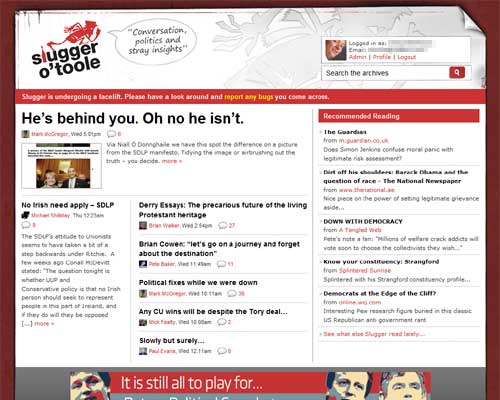
If you have any interest in Northern Ireland politics, you’ll be familiar with Slugger O’Toole. It’s by far the best known blog in the province, and manages to pull off the impressive feat of appealing to both sides of the sectarian divide – even to the point of winning awards at ceremonies in both the UK and the Republic. And as an Ulster exile myself, it’s a site I’ve followed for a long, long time.
Late last year, Slugger received investment from Channel 4’s 4iP fund, to take things to the next level. In practice, that meant an update to a design that was really showing its age; and a move from Expression Engine to WordPress. But things didn’t work out with their initial Belfast-based designer; and a few weeks ago, they got in touch to see if Puffbox could help. The no1 website from my part of the planet, wanting to move to WordPress? How could I possibly refuse?
The brief was to reflect the rough and robust nature of the site’s conversations; and pretty quickly,we found a visual style which seemed to strike the right note. But when it came to wireframing, we hit an interesting question: did Slugger want to be more of a blog or a news site?
Our initial templates were definitely more bloggy in nature, but they just didn’t feel right. Like a lot of sites, Slugger’s traffic has always been driven by news events. And as I think I’d always suspected deep down, we eventually concluded it had to be more newsy – and started again.
Most of the effort went into the homepage – and specifically the opening frame (or two), which could well be from a newspaper site, if it weren’t for the ‘torn edges’ effect. And therein lies the aspect of the project I’m most proud of: the self-managing ‘front page’.
If it was a newspaper, it would have an editor (or probably several) tasked with choosing the right order for the stories, tweaking the headlines, crafting snappy summaries, selecting suitable imagery, and so on. But Slugger is run by a loose bunch of volunteer contributors, and couldn’t commit to that kind of management overhead. So instead, we’ve programmed WordPress to select the stories, and sort them, based on a number of predefined rules.
It selects stories based on their date of posting, the editor’s manual identification of ‘important’ stories, whether or not it’s got pictures, and most interestingly, the volume of comments. So a story will almost always get some top-of-page exposure when it’s first published, but will soon drop ‘below the fold’. However, if it generates a good number of comments, it will jump back up to the top – and in all likelihood, even higher than before.
Sure, it’s not quite Digg or Google; but I think it’s interesting that the site’s readership can influence the homepage almost as much as the editor. And it seems entirely in keeping with the ethos of a site whose true strength is in its sense of community.
On the technical side, it’s been really pretty tricky. Thousands of already-registered users, tens of thousands of posts, hundreds of thousands of comments – and the server procured by our predecessors on the project just wasn’t up to the task. Things were agonisingly slow on launch day, no matter how many magic tricks Simon Wheatley performed: so we had to make hasty plans to move it somewhere beefier (and as it turned out, cheaper). Thankfully though, we seem to be in calmer waters now.
Knowing the Slugger readership as I did, I feared the worst when it came to reader feedback. In fact, it’s been overwhelmingly positive. People seem to like the visual approach, and appreciate what we’re trying to achieve with it. We’re fixing the (relatively few) bugs which have arisen, and the contributors are getting used to the new interface and the new functions at their disposal. And of course, this is really only the start: having moved everything over into WordPress, all sorts of possibilities now open up.
Several gold stars go to Simon Wheatley, for going far beyond the call of duty on this one; and thanks to Matt at Dunston Graphics, for getting the design just right, and coping admirably with my outrageously late change of strategic direction.



 We’ve gone for a high-impact homepage, with a large image carousel highlighting a number of key local issues: and as with Lynne Featherstone’s site, each issue has its own explanatory page which can act as a hub for related posts. Unlike Lynne though, a large proportion of Chris’s work is at national level – so we’ve gone for a
We’ve gone for a high-impact homepage, with a large image carousel highlighting a number of key local issues: and as with Lynne Featherstone’s site, each issue has its own explanatory page which can act as a hub for related posts. Unlike Lynne though, a large proportion of Chris’s work is at national level – so we’ve gone for a 